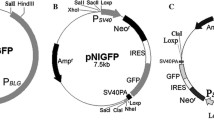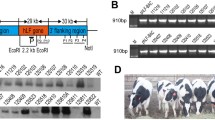Abstract
A vector expressing human lysozyme (pBC1-hLYZ-GFP-Neo) was evaluated for gene and protein expression following liposome-mediated transformation of C-127 mouse mammary cancer cells. Cultures of G418-resistant clones were harvested 24–72 h after induction with prolactin, insulin and hydrocortisone. Target gene expression was analyzed by RT-PCR and Western blot and recombinant human lysozyme (rhLYZ) bacteriostatic activity was also evaluated. The hLYZ gene was correctly transcribed and translated in C-127 cells and hLYZ inhibited gram-positive bacterial growth, indicating the potential of this expression vector for development of a mammary gland bioreactor in goats. Guanzhong dairy goat skin fibroblasts transfected with pBC1-hLYZ-GFP-Neo were used to construct a goat embryo transgenically expressing rhLYZ by somatic nuclear transplantation with a blastocyst rate of 9.0 ± 2.8 %. These data establish the basis for cultivation of mastitis-resistant hLYZ transgenic goats.




Similar content being viewed by others
References
Aoyama M, Agari K, Sun-Wada GH et al (2005) Simple and straightforward construction of a mouse gene targeting vector using in vitro transposition reactions. Nucl Acids Res 33(5):e52;1–8
Campbell KH, Fisher P, Chen WC et al (2007) Somatic cell nuclear transfer: past, present and future perspectives. Theriogenology 68(Suppl 1):S214–S231
Gong GC, Dai YP, Fan BL et al (2004) Production of transgenic calves by somatic cell nuclear transfer. Chinese Sci Bull 49(2):161–166
Higashibata Y, Sakuma T, Kawahata H et al (2004) Identification of promoter regions involved in cell- and developmental stage-specific osteopontin expression in bone, kidney, placenta, and mammary gland: an analysis of transgenic mice. J Bone Min Res 19(1):78–88
Ibrahim HR, Matsuzaki T, Aoki T (2001) Genetic evidence that antibacterial activity of lysozyme is independent of its catalytic function. FEBS Lett 506(1):27–32
Liu FJ, Zhang Y, Zheng YM et al (2007) Optimization of electrofusion protocols for somatic cell nuclear transfer. Small Rumin Res 73(1–3):246–251
Muraki M, Jigami Y, Tanaka H (1986) Expression of synthetic human lysozyme gene in Escherichia coli. Agric Biol Chem 50(3):713–723
Platenburg GJ, Kootwijk EP, Kooiman PM (1994) Expression of human lactoferrin in milk of transgenic mice. Transgenic Res 3(2):99–108
Rius M, Obradors A, Daina G et al (2010) Reliability of short comparative genomic hybridization in fibroblasts and blastomeres for a comprehensive aneuploidy screening: first clinical application. Hum Reprod 25(7):1824–1835
Tanaka S, Ikeda H, Otsuka N et al (2003) Tissue specific high level expression of a full length human endogenous retrovirus genome transgene, HERV-R, under control of its own promoter in rats. Transgenic Res 12(3):319–328
Tao Y, Han W, Zhang M et al (2009) Production of Boer goat (Capra hircus) by nuclear transfer of cultured and cryopreserved fibroblast cells into slaughterhouse-derived oocytes. Czech J Anim Sci 54(10):448–460
Tollefson AE, Stewart AR, Yei SP et al (1991) The 10,400- and 14,500-dalton proteins encoded by region E3 of adenovirus form a complex and function together to down-regulate the epidermal growth factor receptor. J Virol 65(6):3095–3105
Wilmut I, Schnieke AE, McWhir J et al (1997) Viable offspring derived from fetal and adult mammalian cells. Nature 385(6619):810–813
Woods CM, Hooper DN, Ooi EH et al (2011) Human lysozyme has fungicidal activity against nasal fungi. Am J Rhinol Allergy 25(4):236–240
Xiong XR, Li WZ, Wang LJ et al (2011) Human lysozyme gene (hLYZ) transgenic bovine embryos produced by somatic cell nuclear transfer. J Agric Biotechnol 19(2):294–300
Yi N, Li N (2010) Transient expression of chicken antimicrobial peptides by mouse mammary carcinoma cells C-127. Protein Pept Lett 17(12):1517–1523
Yoshimura K, Toibana A, Nakahama K (1988) Human lysozyme: sequencing of a cDNA, and expression and secretion by saccharomyces cerevisiae. Biochem Biophys Res Commun 150(2):794–801
Acknowledgments
We are indebted to Mr. Qi Wang and Hui Feng for providing experimental material. We thank Ms. Ronghua Wu, Yani Bian and Mr. Xing Liu in experimental preparation. This study was supported by National Transgenenic New Species Breeding Program of China (No. 2011ZX08008-005; No. 2009ZX08008-007B).
Author information
Authors and Affiliations
Corresponding author
Electronic supplementary material
Below is the link to the electronic supplementary material.
Rights and permissions
About this article
Cite this article
Gui, T., Zhang, M., Chen, J. et al. In vitro evaluation of a mammary gland specific expression vector encoding recombinant human lysozyme for development of transgenic dairy goat embryos. Biotechnol Lett 34, 1445–1452 (2012). https://doi.org/10.1007/s10529-012-0930-7
Received:
Accepted:
Published:
Issue Date:
DOI: https://doi.org/10.1007/s10529-012-0930-7




